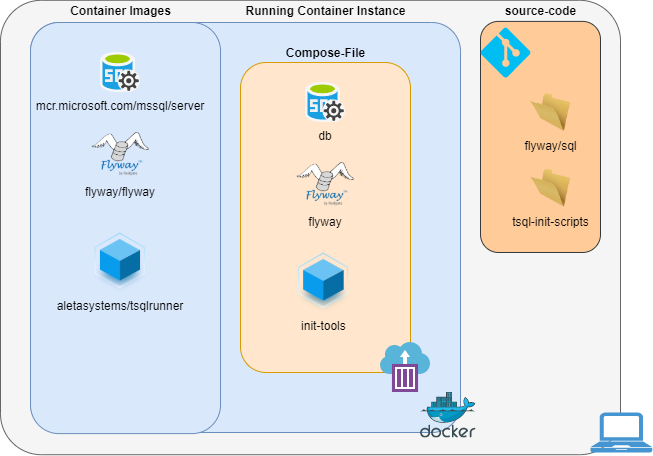Containers | Building a local development environment
Containers, Docker Compose, Local Development, DLM with Containers ·Docker-Compose, Flyway and a T-SQL runner to help you get up and running with a local development environment.
In my introductory posts on docker and docker-compose. We managed to set up an empty SQL Server container, but in the real world, that is not very useful.
Okay great - we can create SQL Server containers now let us build on that to create a ready-to-go development environment with
docker-compose up.
Let us take a moment to talk about the objective. We need a SQL Server, a database and something to deploy code to it (build). We will define a service (an instance of a container) in our compose file for each of these tasks.

Containers used:
SQL Server using image mcr.microsoft.com/mssql/server
A simple T-SQL Script runner aletasystems/tsqlrunner
Flyway for Build/Deployment boxfuse/flyway
Flyway cannot create a database it expects the database to exist before deploying the code. This is why we use aletasystems/tsqlrunner which is a custom-image based on mcr.microsoft.com/mssql-tools.
SQL Server
We have configured our SQL-Server as follows.
- Running on port 14333
- Username
sa - Password is set in a
.envfile
Initialise
We now need to initialise SQL server using the container aletasystems/tsqlrunner.Our initialisation process is really simple, execute a create database script against the master database.
First a quick tour on how aletasystems/tsqlrunner works.
- In your compose file, you map a local directory containing TSQL files to the containers
/tsqlscripts - The local directory follows the convention of
databasename\tsql-filename.sql - The runner will first run the scripts in
master\filename(in alphabetical order) - Then process each database and script (again in alphabetical order)
With this information, we place a create database TSQL script file (create-db.sql) in ./path2initsqlfiles/master
We now add inittools service to our docker-compose file, we configure it as below.
- The SQL Server it connects to is the
dbservice we defined earlier - It users the username
saand password (again it is taken from our.envfile). - We give it the path to the SQL Scripts to run.
Deployment
We will use flyway to deploy our code, but you can plugin an alternative that suits your need. I found flyway the easiest to work with, it is a fantastic tool and I hope to write/talk about it in the future.
I won’t get into too much detail about how flyway works as that deserves it own post, but if you are interested you can read How Flyway works
The basics:
volumesshows flyway where theSQL&conffolder arecommandtells it what we want to do along with the various parameters
Some useful commands:
- To re-run flyway with the latest changes to source code
docker-compose restart flyway - To view the flyway log
docker-compose logs -f flyway
How did we control order?
We used the depends_on property to tell each service what it depends on. This is not exactly true, as it is (and from what I understand) the moment a service comes online, docker believes it is ready - which can be problematic as SQL Server takes a few seconds to become accessible.
It is therefore important that your services have a retry/delay mechanism built-in. Flyway has an additional parameter -connectRetries=60 and aletasystems/tsqlrunner has a modest retry mechanism
